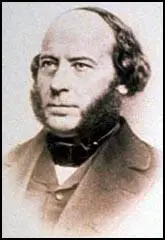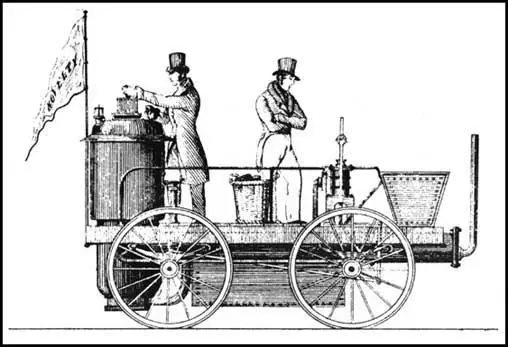John Ericsson

John Ericsson was born in Varmland, Sweden, in 1803. As a young boy he developed an interest in engineering and at the age of 13 produced technical drawings for the Gota Canal. Her served as an officer in the Swedish Army (1816-26) before moving to England to seek sponsorship for a new type of heat engine he had invented, which used the expansion of superheated air as the driving force.
Ericsson lived in London where he formed a partnership with John Braithwaite. In 1829 the two men produced Novelty, one of the entries for the Rainhill Trials. The design was based on road steam carriages being built at that time. Built in six weeks the locomotive had not been tried out before the competition organised by the Liverpool & Manchester Railway took place in October, 1829.
Weighing only 2 tons 3 cwt, the Novelty was much smaller than the other entries. It was also the quickest and reached speeds of 28 mph during the trials that took place on the first day. This was 4 mph faster than the Rocket managed during the opening session. On the second day the boiler pipe became overheated and was damaged. To reach it for repairs, Ericsson and Braithwaite had to partially dismantle the boiler. The steam-tight joints had to be made with a cement which normally took a week to harden. Braithwaite and Ericsson had to go out the next day and not surprisingly when the locomotive reached 15 mph the joints started to blow. The damage was considerable and they forced to retire from the competition.
After the Rainhill Trials Ericsson turned to building ships and in 1836 he developed a successful screw-propeller. Disappointed with the support he was getting in England, he emigrated to the United States in 1839. He continued to experiment and in 1849 he designed Princeton, the first metal-hulled, screw-propelled warship and the first to have its engines below the waterline.
On the outbreak of the Civil War President Abraham Lincoln ordered the United States Navy to build a ship that could help defeat the Confederates. Several leading engineers, including Ericsson, were asked to contribute possible designs for a new ship. When Ericsson's proposal, the Monitor, was rejected by the navy, he managed to obtain a special meeting with the president. Lincoln was impressed with Ericsson's ideas and was granted the contract.
Construction of the Monitor began in October 1861. Completed in just 118 days, it was built at a cost of only $275,000. The ship, almost entirely made of iron, had an armoured revolving turret that held two cannon. This two-gun warship with its 57 man crew was used to successfully blockade the Confederate coast.
Ericsson's inventions revolutionized navigation and the construction of warships including his ship The Destroyer (1878), which could launch submarine torpedoes. He also explored the possibility of using solar energy and gravitation and tidal forces as sources of power. John Ericsson died in 1889.

The Novelty, during the Rainhill Trials in 1829.
Primary Sources
(1) (1) The Mechanics Magazine (10th October, 1829)
The next engine that exhibited its powers was "The Novelty" of Messrs. Braithwaite and Ericsson. The great lightness of this engine, (it is about one half lighter than Mr. Stephenson's) its compactness, and its beautiful workmanship, excited universal admiration; a sentiment speedily changed into perfect wonder, by its truly marvellous performances. It was resolved to try first its speed merely; that is at what rate it would go, carrying only its compliment of coke and water, with Messrs. Braithwaite and Ericsson to manage it. Almost at once, it darted off at the amazing velocity of twenty-eight miles an hour, and it actually did one mile in the incredibly short space of one minute and 53 seconds! Neither did we observe any appreciable falling off in the rate of speed; it was uniform, steady, and continuous. Had the railway been completed, the engine would, at this rate, have gone nearly the whole way from Liverpool to Manchester within the hour; and Mr. Braithwaite has, indeed, publicly offered to stake a thousand pounds, that as soon as the road is opened, he will perform the entire distance in that time.
(2) The Liverpool Mercury (October, 1829)
We may consider the trial of the Locomotive Engines as now virtually at an end. It is much to be regretted, that "The Novelty" was not built in time to have the same opportunity of exercising that Mr. Stephenson's engine had, or that there is not in London, or its vicinity, any railway where experiments with it could have been tried. It will evidently require several weeks to perfect the working of the machine and the proper fitting of the joints, and under this impression, Messrs. Braithwaite and Ericsson have acted wisely in withdrawing, us they have done, from the contest.
In withdrawing so honorably from the competition, Messrs. Braithwaite and Ericsson have done themselves the highest credit, and they may rest assured that the scientific world will do justice to their efforts, and look with anxiety to a speedy completion of their elegant and compact engine prepared to bear the fiercest "ordeal" which the judges may please to direct.
The Novelty" still remains at Liverpool, and Messrs. Braithwaite and Ericsson have publicly announced that as soon as it is repaired, and the cement of the joints sufficiently hardened, they will (with the leave of the Directors) complete the exhibition of its powers; and show that but for the accidents which it unfortunately met with, it was more than equal to the accomplishment of the task this was last assigned to it.
The course is thus left clear for Mr Stephenson; and we congratulate him, with much sincerity, on the probability of his being about to receive the reward of £500. This is due to him for the perfection to which he has brought the old-fashioned locomotive engine, but the grand prize of public opinion is the one which has been gained by Messrs. Braithwaite and Ericsson, for their decided improvement in the arrangement, the safety, simplicity, and the smoothness and steadiness of a locomotive engine; and however imperfect the present works of the machine may be it is beyond a doubt - and we believe we speak the opinion of nine-tenths of the engineers and scientific men now in Liverpool — that it is the principle and arrangement of this London engine which will be followed in the construction of all future locomotives.
